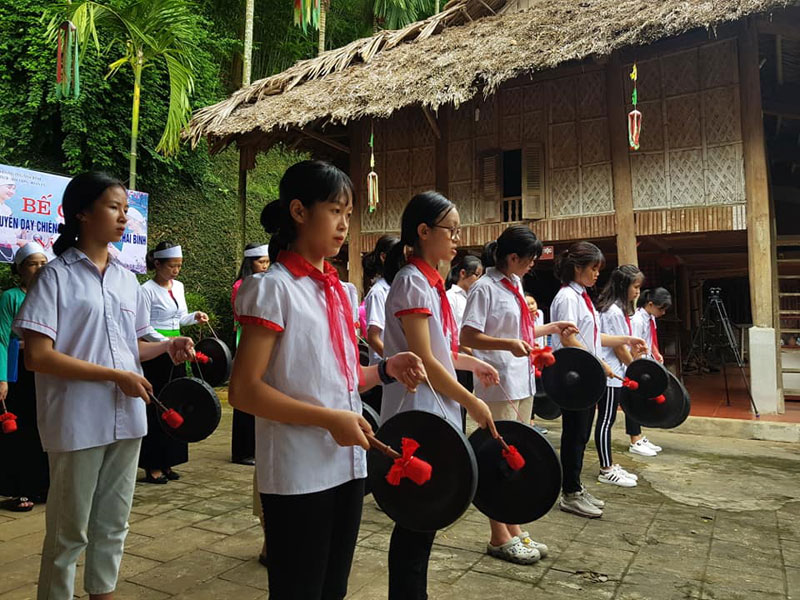
(HBO) - For Muong people, gongs are the soul and treasure. The sound of gongs has become an indispensable cultural activity in the spiritual life of Muong people. As a ward with nearly 40% of the Muong ethnic population, for many years, the Party Committee, the appropriate authorities and the people of Thai Binh Ward (Hoa Binh City) have always paid attention to the conservation and preservation of Gongs and Muong Gong culture.

The students of Thai Binh Secondary & High School (Hoa Binh City) are participating in the Muong Gong teaching class.
Mr. Bui Thanh Binh, the director of the Muong Cultural Heritage Museum, who is devoted to the Muong ethnic culture, with the Muong gongs, an enthusiastic teacher giving free lessons at the family's museum says: Thai Binh Ward has organized a class to teach Muong ethnic gongs to 60 students, of which the main force is young people. I am very excited to teach them. The students have been learning quickly, passionately and excitedly with the gong lessons. These are the positive signals for the locality to continue replicating the factors and the dedicated teams with Muong gongs, and the Muong gong culture.
Ms. Tran Thi Cuc, the Vice Chairman of the People's Committee of Thai Binh ward says that currently, there are 3 Muong gong teams in the ward. Three gong teams regularly perform in local and provincial events, festivals and anniversaries. With 60 students being taught Muong gong this time, in addition to equipping them with the technology how to beat the traditional gong to conserve, preserve and promote the value of Muong Gong culture, contributing to furthering the local cultural and arts movement. The Muong gong teaching class also has another purpose with an important meaning, which is to expand the gong teams, promoting the spread and the inheritance. Therefore, the Organizing Committee has gathered students with diverse ages, including students from 10-15 years old.
Witnessing the students' confidence after the presentations at the closing ceremony of the Muong Gong teaching class, the members of the class organizing committee are all very happy, believing that they will become the nucleus to spread the spirit, the love and the value of Muong Gong to the same age group. And the female members and young people will also confidently build and replicate the nucleus, the clubs and the models to preserve and promote the cultural identity of Muong gongs. Stemming from here, the local government is more determined in preserving and expanding Muong gong training movement, associating Muong gongs with the movement of the local culture, art and sports. Especially, the value of Muong gongs in political and social events and the local festivals has been promoting.
In the coming time, the ward will select and build a gong team and special contents to attend the events of the Provincial Cultural and Tourism Week in 2019, being held in November in Hoa Binh City.
With an increasingly vibrant and widespread emulation movement aimed at building cultured residential areas and cultured families, Yen Thuy District has been making steady progress toward improving both the material and spiritual well-being of its people, while fostering a civilized, prosperous, beautiful, and progressive community.
Once lacking recreational spaces and community facilities, Residential Group 2 in Quynh Lam Ward (Hoa Binh City) has recently received attention for the construction of a new, spacious, and fully equipped cultural house. The project followed the model of state support combined with public contributions in both labor and funding.
The "All people unite to build cultural life" movement, which has been effectively integrated with Kim Boi district’s socio-economic development goals, is fostering a lively spirit of emulation across local residential areas, hamlets, villages, public agencies, and enterprises. In addition, through the initiative, traditional cultural values are being preserved and promoted, while community solidarity and mutual support in poverty reduction and economic development are being strengthened.
A working delegation of the Hoa Binh provincial People’s Committee led by its Permanent Vice Chairman Nguyen Van Toan on June 11 inspected the progress of a project to build the Mo Muong Cultural Heritage Conservation Space linked to tourism services in Hop Phong commune, Cao Phong district.
Born and growing in the heroic land of Muong Dong, Dinh Thi Kieu Dung, a resident in Bo town of Kim Boi district, in her childhood was nurtured by the sweet lullabies of her grandmother and mother. These melodies deeply imprinted on her soul, becoming an inseparable part of her love for her ethnic group's culture. For over 20 years, this love for her hometown has driven Dung to research, collect, and pass down the cultural values of the Muong people to future generations.
In the final days of May, the Ethnic Art Troupe of Hoa Binh Province organized performances to serve the people in remote, mountainous, and particularly disadvantaged areas within the province. These were not just ordinary artistic shows, but they were the meaningful journeys aimed at spreading cultural values, enhancing the spiritual life of the people and contributing to the preservation of ethnic minority cultural identities.



